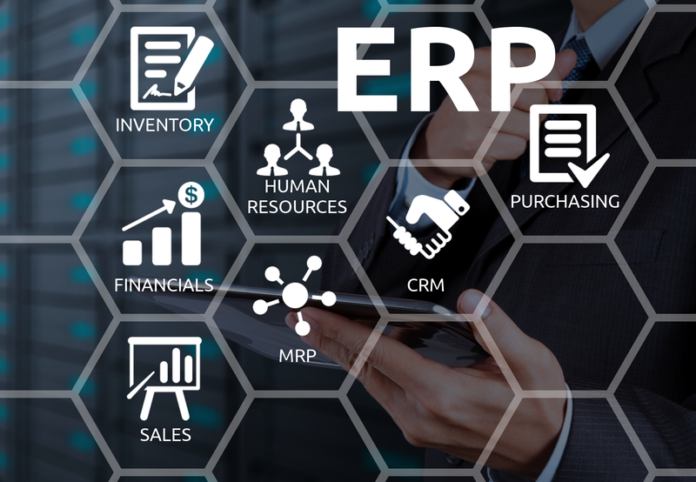ERP systems are usually structured in three parts.
- All data relevant to the company is stored in the database – this is usually data from the customer file, invoice data, data on stock levels, prices and marketing measures.
- The application level follows the logic of the business processes within the company.
- The third level is the user interface as presented to the employee.
The benefits of the ERP system can be illustrated using the example of customer and invoice data. The data of an existing customer is entered into the common database, to which sales and the billing department have access, as does the marketing department. If an update is required, this is done uniformly for all departments since they access the same database. Typical problems such as incomplete or double entry of data are eliminated. All departments can use all existing data for their business sub-processes. Of course, this applies to customer data and internal and exaggerated data and events. Data can not only be mapped but also used for other processes such as calculation, inventory overview, accounting,
ERP over time
The ERP is the further development and bundling of various data collection and uses, as has been practiced for around five decades. The origins of ERP systems can be seen in the first IMC (Inventory Management and Control) applications and MRP (Material Requirement Planning) systems. With the help of IMC, the inventories could be electronically controlled and managed. MRP was used for material planning and procurement and, thus, for controlling and improving production processes. Since the 1980s, production, material procurement, warehousing, finance and sales processes are no longer recorded and managed individually but via MRP-II systems. Finally, in the 1990s, a system was created with ERP.
Areas of application for small and medium-sized companies
With the further development of ERP, this is no longer only available to large corporations. The implementation is also worthwhile for small and medium-sized companies that want to make their business processes more effective in purchasing and sales, storage and distribution, finance and accounting, production, marketing, and service. For example, with ERP software development company, offers can be calculated, and stock levels or process flow can be checked. Where are the strengths where are weaknesses of a company? Are financial and human resources used optimally? How can ordering and payment processes be further improved? What adjustments are required so sales and customer service can react even more directly to customer requests and suggestions? The potential that ERP offers companies lies in these and many other possible applications. Classic applications are manufacturing, merchandise management, control, CRM, human resources, warehouse management, procurement, PPS and other functions.
Which provider is the right one?
Microsoft and Oracle are probably familiar to most interested parties as enterprise systems, but they are not the only providers. It is worth evaluating other providers, some of which offer a larger or different range of functions, e.g., Mavenup Creatives
enterprise software.
Ultimately, the requirements made by the respective company decide which ERP system is suitable. In contrast to SAP, Sage offers business software with the “Office Line Evolution” business software that meets the needs of medium-sized companies. Other software providers have specialized in specific industries. Solution AG mainly realizes software implementations in metal, mechanical and plant engineering. The Munich-based TPG (The Project Group) is primarily aimed at project managers with its range of software. At the same time, 5 Point AG has created a solution with “project facts,” which should primarily benefit service providers as an “all-in-one” solution. Finally, Mavenup Creatives sells business software from the cloud, where customers have the option of selecting exactly those modules they need to keep their investment low. Overall, the range is very diverse – which underlines the need to check which software best suits the company structure before purchasing an ERP system.
Advantages and disadvantages of an ERP system
The advantages of ERP systems should have already become clear from the previous description. It reduce costs and promote cooperation between all departments and employees (the so-called users). Adjustments to changes in the market and the determination of future strategy. Temporary difficulty arise when introducing extensive ERP systems
- due to inaccurate or faulty planning,
- by the need to persuade and train employees to use it,
- due to the time-consuming and cost-intensive implementation.
The introduction of ERP software sometimes makes it necessary for a company to adapt its business processes to the software in certain areas.
Important selection criteria
ERP software is only as good as it can be changed to fit what a company needs. However, no ERP system can meet all requirement. And no provider has ready all the solutions for the various industries and service provider. It is, therefore, of particular importance to find out thoroughly about the actual scope of services. The service and the flexibility of the software and provider before the introduction. In addition to the information, the companies have given. Other sources of information should also be used. Such as user forums or customers already working with the preferred software. Involving the company employees can also be helpful. As they are usually better able to assess the needs of their job. Or department than the company management.
Use ERP from the cloud
Not every company or service provider needs a server-based solution for ERP systems. Smaller and leaner solutions can often be the better alternative. ERP models are also offered as Software-as-a-Service (SaaS) from the cloud. As a rule, the customer then chooses a range of modules that fit his company exactly. The advantage is that he does not have to deal with administration or purchase basic technical equipment. In addition, the offers are inexpensive since only the required modules have to be paid for with a monthly basic fee.
Click here to read more articles.








